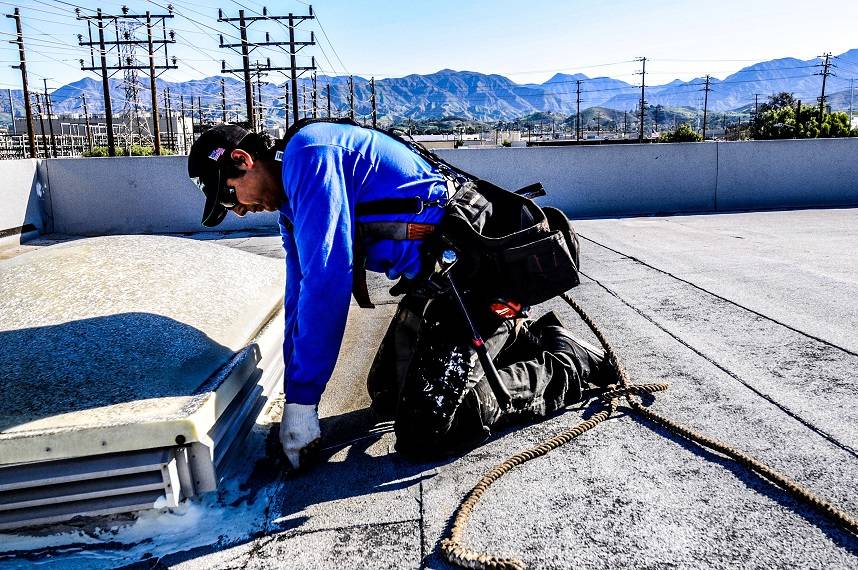Schedule Free Estimate
3 Reasons Why CA Insurance Companies are Dropping Roof Coverage Find Out Now!
In recent years, commercial property owners in California have been facing a new challenge: insurance companies are increasingly dropping coverage for commercial roofs. This trend is leaving building owners and commercial roofers in a bind, as they must navigate stricter requirements and make costly upgrades to maintain their policies. So, why are insurance companies pulling back, and how is this affecting the roofing industry? Below are three key reasons behind this shift and what it means for commercial roofers.
1. Increased Risk of Wildfires and Natural Disasters
California’s susceptibility to natural disasters, especially wildfires, is one of the primary reasons insurance companies are reevaluating their policies. In areas with a high wildfire risk, older or improperly maintained commercial roofs are considered a liability. Wildfires can spread rapidly, and if a commercial building has a roof that isn’t fire-resistant or up to modern codes, it could face complete destruction, resulting in significant payouts for insurance companies.
Insurance providers are now more selective, focusing on roofs made from fire-resistant materials like silicone coatings or those reinforced with modern, durable systems. This has created an opportunity for commercial roofers who specialize in installing fire-resistant roofing systems. Roofers can help building owners stay insured by offering solutions that meet the latest fire-safety standards. However, many commercial roofers are also feeling the pressure to keep up with new codes and safety regulations to meet this growing demand.
2. Aging and Deteriorating Roofs
Many commercial roofs in California are reaching the end of their life span. Roofs that haven’t been replaced or properly maintained become a major risk for insurers, as they are more susceptible to leaks, structural failure, and damage from natural disasters. Insurers often drop coverage on these aging roofs to avoid the costly payouts that come with significant repairs or roof collapses.
For commercial roofers, this presents both a challenge and an opportunity. The demand for roof replacements and repairs is increasing as building owners scramble to bring their properties up to code and avoid losing insurance coverage. Commercial roofing companies with expertise in restoring aging roofs are well-positioned to capitalize on this trend. Offering comprehensive inspection and maintenance services can help property owners identify and address potential issues before they escalate, keeping roofs insured and extending their life span.
3. Stricter Insurance Underwriting Guidelines and the effect on Commercial Roofers
As insurance claims for property damage in California have soared, insurance companies have tightened their underwriting guidelines. They now require more detailed assessments of commercial roofs, including information on the roof’s materials, age, and condition. Roofs that don’t meet these strict criteria are being flagged as high-risk, resulting in dropped coverage or significantly higher premiums.
For commercial roofers, understanding these insurance guidelines is crucial. Roofers who stay informed about current insurance requirements and provide solutions that comply with these new standards will have a competitive edge. This shift is also pushing roofers to offer more high-quality, insurance-compliant roofing materials, such as cool roof coatings or silicone systems, which are known for their durability and energy efficiency. By helping building owners meet insurance standards, commercial roofers can provide added value and ensure their clients remain covered.
Conclusion
The growing trend of insurance companies dropping coverage for commercial roofs in California is a direct result of increased wildfire risk, aging infrastructure, and stricter underwriting guidelines. For building owners, this can mean costly upgrades and potential loss of coverage. However, for commercial roofers, this shift represents a significant business opportunity. By offering fire-resistant materials, performing detailed inspections, and staying ahead of evolving insurance requirements, roofing contractors can help their clients navigate this challenging landscape and ensure that their commercial properties remain insured.
As the landscape continues to change, commercial roofers who adapt to the needs of their clients and the demands of the insurance industry will be best positioned for success.
Central Roofing Company Headquarters
555 W. 182nd Street
Gardena, CA 90248
310-527-6770

Get A Quote
One of our roofing estimators will gladly meet you to discuss your options and follow up with a free, no-obligation, written estimate.
At Central Roofing Company, we understand that a sturdy and reliable roof is crucial for the success and safety of your commercial property. Our team of highly skilled and trained roofing professionals is committed to delivering exceptional craftsmanship and superior service in every project we undertake.
555 W. 182nd St. Gardena, CA 90248
Ph: 310-527-6770
Our Office Locations:
Our Services
CA license #684960 – Central Roofing, 2025 ©All Rights Reserved | Terms of Use | Privacy Policy | Built by Dymic